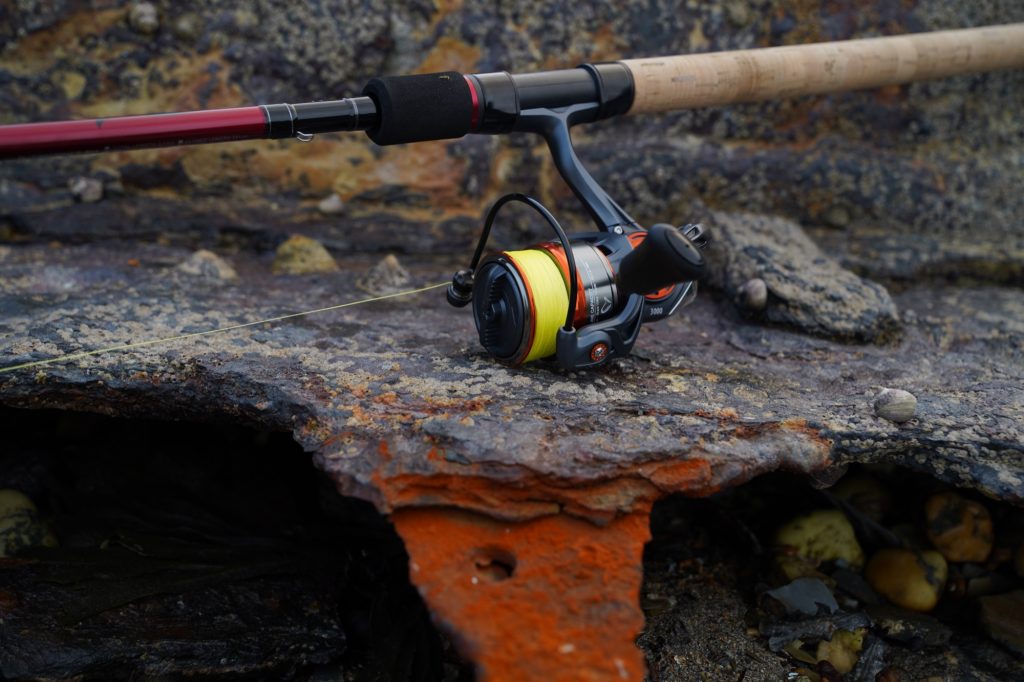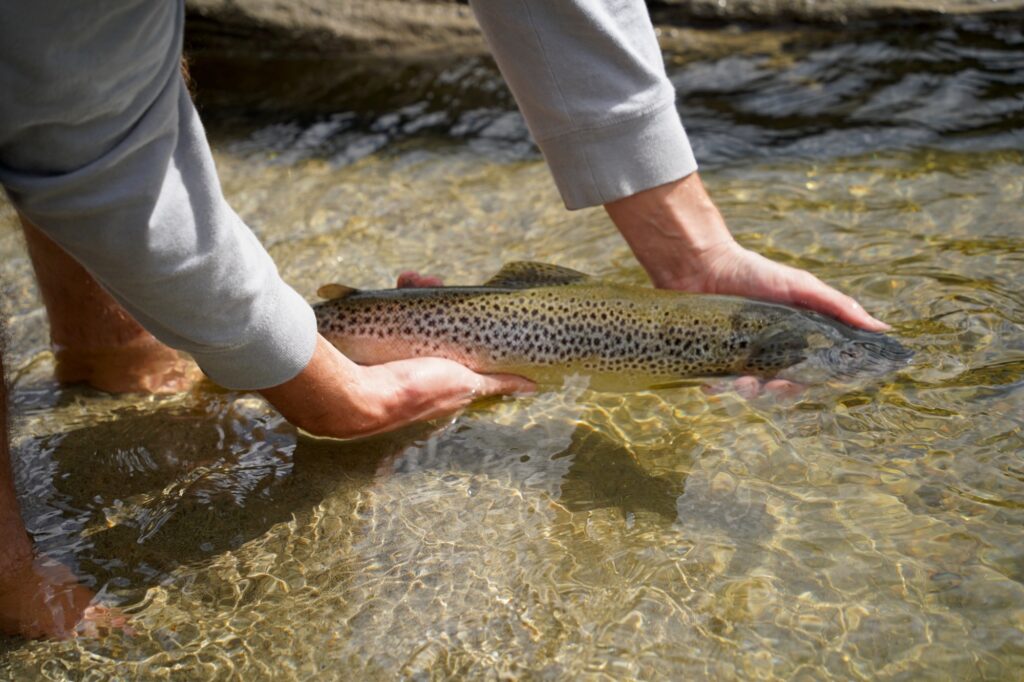
The Perch Rod Guide | Stalking predators with light tackle
The best rods for lure fishing for perch are ultra-lightweight. If you’re fishing in small ponds or canals, there’s no need for a rod that casts more than 10g (1/3rd oz). A rod like this has the sensitivity to pick up on subtle bites during drop shot rigs in winter, and is also a lot of fun to fish with.
A time you might need something with a higher casting weighting than this is if you are fishing slightly larger plugs in large reservoirs or lakes, where you need a stiffer tip and a longer cast. If you fish in waters with pike present, then a rod that casts up to around 25g gives you a little bit more chance should you catch one as bicatch. To target pike and perch and zander on one rod – you’ll want something casting around 30g. It’ll be overkill for the perch and underpowered for the pike – but a great all-rounder. If you grab an ultra light lure rod with one of these casting ranges, and your rod is around 8ft, you can’t go too far wrong. But, as we shall see, not all rods meeting this description are made equal…
Fishmag is reader-supported and earns commissions from affiliate sales, such as from amazon.
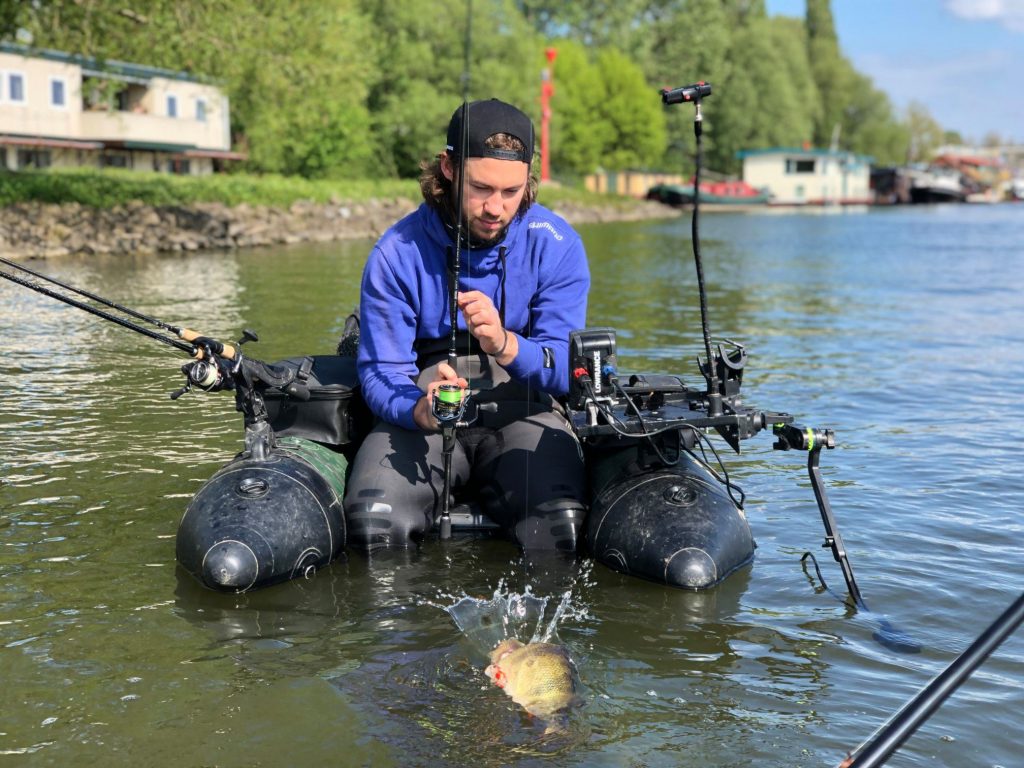
FISHMAG is not sponsored and earns commissions from any sales via our tackle shop partners.
A very sensitive rod is required in order to feel all those perch bites. Some hits will be noticeable on almost any spinning rod. Others are subtle, like a sudden alleviation of tension on the rod tip – almost like an anti-bite. You can only feel those on a very sensitive rod.

The best perch rods
The perch has a mouth that inhales prey – it creates something like a vacuum in its mouth. When the mouth opens, water floods in. A rod that is sensitive enough will allow the perch to move the lure a few inches with minimal resistance. A rod that’s too stiff could result in lures being yanked out of the fish’s mouth.
The exact same rods used for LRF in the sea make for perfect perch rods. We’re looking for something that can present ultra light lures with finesse.

It’s also more fun targeting these fish with lighter tackle since they never grow above 6lb. The rods that work best for perch are the same as the rods popular amongst LRF anglers.
What’s the best casting weight for a perch rod?
The best upper casting weight for a perch rod is around 10-15g. A the lower range of 1-2g helps casting the lightest lures. This is the best set-up as long as pike are not heavily present in the water you’re fishing. The HTO Nebular Light Gamer is a good example. If larger pike are present, a rod that casts 20-30g would be more prudent. You can’t filter out all the pike, even when fishing with smaller lures. For pike-filled larger lakes, we’d use what we normally call a ‘bass rod‘ because the casting weight needed is the same.

What’s the best lure rod length for perch?
The value of shorter rods for perch
A perch rod of 7ft is generally accepted as the standard size because it offers more control and manoeuvrability in tight areas. These areas might include under a bridge or a tree where fishing with a longer rod is not easy. In waters that are heavily vegetated, I have used a 6.5ft rod. This is especially useful when the only option is to fish from up trees! Shorter rods contribute to more casting accuracy. A 7.5ft rod will be ideal for most people.
8ft might be the best rod length for fishing big lakes
An 8ft rod is a sensible upper limit for most people. It proves useful in waters where a longer cast is beneficial, such as larger lakes and lochs. A longer rod makes it easier to hold lures deeper in the water when you’re standing high above the water (with the rod tip pointed down). It also makes it easier to hold your lure’s position if you want to fish the central channel of a canal or river. The key rule to remember here is: Shorter rods provide more control and manoeuvrability. Longer rods are helpful when fishing in bigger, more open venues.

Best rod action for perch fishing
The type of perch lures you use will likely determine what rod action you choose. It really comes down to personal preference and this is one of the many areas of fishing where you will receive contradictory advice!
Most people generally prefer faster actions, but don’t worry about it too much. Some people find that their casting is more accurate with faster action rods. On the other hand, a slower action rod will wobble after the cast, leading to more randomness in the delivery of the lure. Slower actions can be useful when fish are very tentative. If fish respond poorly to feeling too much resistance when they take the lure, a slower action can be a more finesse approach.
Faster action rods are better with perch plugs
Many prefer rods with faster actions if you mainly fish with plugs. These rods hold their form better against the plug’s resistance in the water. They snap back to being straight faster because the rod bends more at the tip and less in the lower section of the rod. A slow action rod would bend more as you retrieved the lure. This bending occurs further down in the rod, which can reduce bite sensitivity a bit. Bites will be absorbed lower down in the rod blank than they would be if the rod was straight at the time of the bite.

Should you get a solid or tubular tipped perch rod?
For fishing with soft plastics, a solid tip is superior. However, a tubular tip handles the action of hard lures better. It has a faster action. After twitching a lure, the rod snaps back to being straight. A solid tip would absorb more of the resistance and snap back less decisively.
When using soft plastics for fishing, particularly the smallest ones, a solid-tipped rod proves beneficial due to its increased bend into the lure. Tubular rods, on the other hand, are more suitable for drop-shotting and hard lures. They offer more bite sensitivity in the blank, but less visual aspect. For example, when you’re dead sticking, which means leaving a lure still and not retrieving it, in the midst of a British winter, a solid-tipped rod becomes handy. It enables you to detect the smallest bites from fish. These fish have lower metabolisms and more tentative feeding behaviour during this season.
Best reels for perch fishing UK
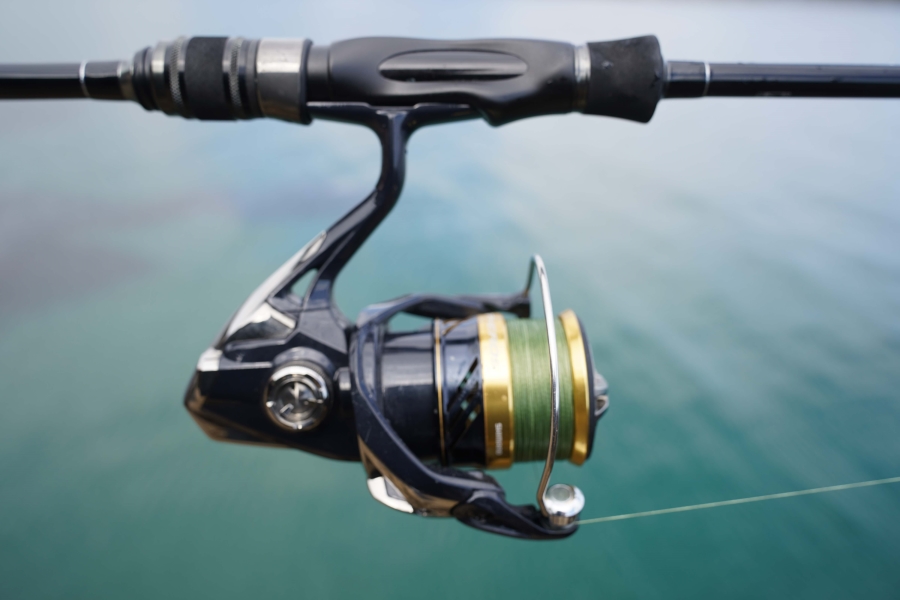
The best perch spinning reels fall within the sizes 1000 – 3000. For most people, 2500 / 3000 proves ideal. Take the Daiwa Ninja as an example. If you seek a very cheap reel, this guide will not assist you. The reason is that each part of your lure fishing setup relies on the other parts for proper functioning. If your reel is substandard, your nice braid or lightweight fluorocarbon line will tangle. Consequently, the reel will likely struggle with lighter lines. This makes fishing with lighter lures more challenging. Quality holds more importance with ultra-light spinning outfits than with regular spinning rods.
If you’re unsure about reel sizes, get a perch rod & reel combo
If you’re unsure about what reel size to get for your rod or a rod you’re looking at buying, consider buying a rod and reel combo together, or contact FISHMAG and we’ll help you find the right size.
You should ideally aim to purchase a Daiwa or Shimano, spending at least £50 to ensure quality. If you contemplate buying a different brand, FISH MAG can verify its worth, as other good options exist. Shimano and Daiwa reels priced at £30 are functional. At £60, they become more appealing, and at £100, they transform into a superior product. However, a word of caution – once you experience fishing with a reel that costs double, returning to a cheaper option becomes impossible. I believe that significant functional improvements happen up to about £70. Yet, as you invest more, reels become smoother and sturdier.
Be very careful with reels that look shiny and nice on the outside but cost under £30, because you can’t tell how good a reel is by how shiny and slick it looks!
Perch fishing set-ups, with UK Predator Champion Thom Hunt
Thom Hunt is the Captain of the Team England Lure Squad & an international competition angler. We thought we’d polish off this guide to perch fishing set ups with one of the countries experts. Full discolure, Thom works with Westin, the Scandanavian tackle company.
“If you’re just getting into perch fishing, keep it light” – says Thom.
“We’re going to go through rods, braid and a little bit about my absolute go-to beginners method, which is a jig head and a shad. This is the easiest way to fish.”
“There are a few key items in the following list. As long as you’ve got those, you’re good to go. You don’t need tons of stuff. One rod, a net and a handful of lures, and away you go…”

7ft is the most versatile length and 5-15g is the most versatile casting weight
7’ 5-15g – all rounder
7′ is the best all-round length for a perch rod. Rods shorter than that are a bit specialist and longer than that is getting into Pike territory or longer casting. A casting weight of 5 to 15g is my recommendation for versatility.
2-10g for small canal perch with tiny jig heads
“I typically use this for small perch on canals when I’m going really light on my jig heads, like 1-3g jig heads.”
“Most of your canal perch fishing is going to be for fish of 1-10 ounce. Soft lures of 2.5” or more is a cut-off point where you’re targeting pike too!”
7-21g for reservoir fishing
“There’s also a heavy version 7 to 21g which is more for my reservoir fishing.
“For an allrounder, the 5 to 15g can do everything from a bit of canal fishing (it’s maybe a touch heavy for canals but still in the ballpark), through to small-medium sized rivers. I can even do a bit of light reservoir stuff on this 5 to 15g. If you’re only looking for one rod, this is the one.”
Example rod: The Westin Finesse T&C: The Swiss Army Knife of Perch Fishing Rods
“The Weston finesse TNC stands for ‘Texas and Carolina’. This rod is what I call the Swiss army knife of perch fishing rods. As an International Tournament angler I love these rods because I can basically do anything on them.”
“For Perch and Zander, especially when fish soft plastic baits, you want a rod that has a fast, sensitive, responsive tip and the middle and butt sections remain almost straight. This creates a feel that is highly sensitive, and also allows the fastest reaction in terms of setting the hook after you feel the bite.”
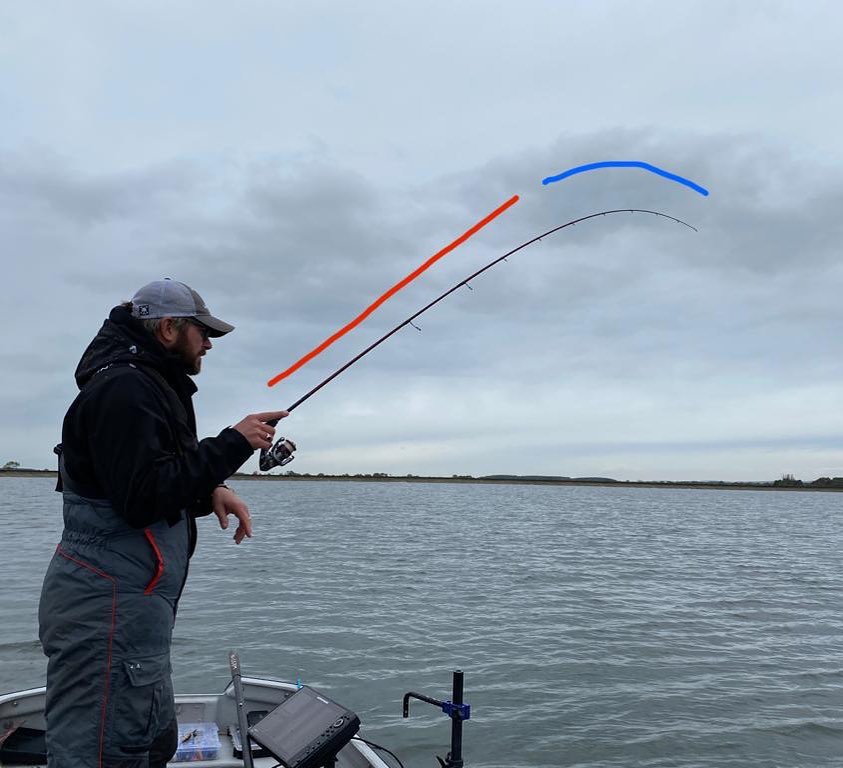
So, what rod action do you reckon is best for perch?
“Fast action is desireable, but not ultra-fast.”
“The action (of the Westin T&C) is medium fast to fast action. They’re not ultra-fast, which is a bit of a trend these days, but they’re fast enough to have beautiful fish-playing action. They’re also mega sensitive and they’re brilliant all-round. I can fish a drop shot on this rod, a crankbait, a chatterbait, a soft plastic, a ned worm – I can do everything on the Finesse TNC.
“It comes in both W2 (RRP £79.99) W3 (RRP £119.99) and W6 versions (£259.99) and the reason we’ve sold so many of the W2 & W3 is purely down to the action. They’re usually cheaper rods, due to the way they are made, the amount of carbon content etc and are a bit of the soft side, but even though the W3 is Westins’ budget range, the blank does not suffer and remains a true fast action. For the money it is exceptional. The W6 however, is even better, a slightly better/crisper action, slightly lighter and the balance is next level….. “
“Absolutely brilliant. Super lightweight, really comfortable handle, really nice detailing and it comes in at a price point which most people like.”
What size reel do you reach for when perch fishing at these competitions?
“Anything from a 1000 to a 2500 is absolutely perfect. They feel just right for your light canal small river stuff. 1000 or 1500 is fine, but if you want to fish the reservoirs or bigger rivers, maybe go up towards 2500.”
As an example, on my W6 in 5-15g I’ve got a 2500 size reel and it pairs up really nicely.

Do you have a favourite braid for perch fishing?
The braid I’ve got on there is the W6 eight-strand braid. Eight strand is super smooth and awesome this is about 25 quid. If you really want to splash out you go up to W10 premium. It’s 13-strand – the highest quality Japanese fibres. In general, I’d go for 0.08 wouldn’t go above 0.12mm.
What breaking strain braid for perch?
Thom says that 8-12lb is strong enough that he can land pike if accidentally hooked while targeting perch, but he focuses more on the details, like diametre of the line, when choosing braid.
“The one you want for general use is 0.08mm which is about 10ish pound. I wouldn’t go much thicker than 0.12mm.”
Why spending £25 on braid is necessary
“There’s probably a few guys out there saying oh but I’m a beginner I don’t want to lose my expensive lure that type of stuff so I’m going to put 25 or 30b braid on… I don’t recommend it because if you’re going to use jig heads as light as a few grams which is what a lot of perch fishing does it’s a bit like trying to fish a float with a 15b Mainline. So come down anywhere between 0.08 and 0.12mm millimeter for your thickness and in poundage terms anywhere between 8-15lb max but 8-12lb is about right.
“Braid is worth it because it’s what transmits the bite up through the rod. It’s really important to get a good quality one. £25 quid is worth spending.”

Watch your braid the way you watch a float…
“We don’t have floats in lure fishing, but you want to watch (your braid) like you watch a float.”
“You can get so much information. If you’ve got a nice thin braid, it doesn’t catch the wind too much. It cuts through the water, so you’re nice and direct with fish. If you’re around a shoal of bait fish, you’ll see tiny little jumps on the line where they’re kicking it and you know that there might be bait fish in the area.”
“Also, tiny bites – especially from zander or small perch – often don’t transmit all the way up the rod. Watching the braid like a hawk is key. Having a bright-coloured braid especially helps with bite detection.”
Leader should be about 1.5-2ft of fluorocarbon at 7lb for perch
Flourocarbon is less visible in the water and more abrasion-resistant. Braid is not suitable for tying direct to lures.
2 1/2 foot of fluorocarbon is fine for perch fishing. Anywhere between 5-10lb is about right for breaking strain. I think 7lb is a nice compromise.

Perch fishing made simple: bounce a 2.5-5g jig head on the bottom.
“Most of the time I’m using a 2.5 to 5g jig head. For beginners out there I’d be picking up some jig heads 2.5 to 5 gram jig heads. It’s a nice compromise weight because it gets you down into the water especially on rivers but doesn’t pick up too much weed and doesn’t get caught on too many rocks. You can still fish as deep as you need to for most situations.”
“I tend to use quite round jig heads because all I’m typically bouncing the soft plastic along the bottom to try and imitate a little bait fish or worm.”
But which soft plastic to rig on this jig head?

The best all-round soft plastic for perch is a little shad – it works for pike, perch and zander
“Soft plastics come in all different shapes and sizes and colors. It’s a mine field as a beginner! My absolute go-to is a simple 5-7cm Shad
My favourite is a Westin Shadteez slim in 5 or 7.5cm size, or a Westin Stanley the stickleback in 7.5cm. It’s so so simple if you’re looking for an all-round soft plastic for pike fishing, a bit of zander and some perch fishing, and you just want to have one type of bait in your box then a little shad is absolutely brilliant.”

Flex in the tail is important
The other thing you want to look for is a bit of flex in the tail. This is where the real action of your lure comes from. You’ll notice that on my jig heads here they’re all very soft because that tail action is what’s doing all the work. You want a nice heavy enough jig head to get you down into the water, but you want a really soft tail to give you some nice tail action.
How Spinners work and when to use them
Spinners are really good for casting out into deeper water. If you find a spot where you think there’s a few perch and maybe you’re getting some tiny little bites but they’re not committing to it then a spinner is also a really good option. It sends out a load of vibration and it’s a little bit heavier, so it gets you down into the water.
Other Essential Equipment
- Net (you don’t need to go spending tons and tons of money but a nice lightweight rubber mesh net is going to be perfect for all situations. A rubber mesh net is a lot easier on the fish. It doesn’t strip off the slime)
- Scissors for cutting braid
- Pliers for removing hooks
- Split ring pliers
- Light wire trace of 10-15lb for venues where pike are present
“You don’t need to spend thousands and thousands on rod rests and seat boxes and all this type of stuff. You can just go fishing with a rod, reel, braid and a couple of lures and away you go.”
Cheers Thom for chatting with us, we appreciate it. And, for FISHMAG readers, thanks for reading.
Savage Gear SG2 Reel Review
Savage Gear SG2 Reel Review Note: since writing this review, we do not recommend these…
Best brown trout lures UK
Best brown trout lures UK Let’s go through every type of brown trout lure and…
The best braided fishing lines, ranked
The best braided fishing lines, ranked We look at the best braids, from the budget…
The Ideal Lure Fishing Set-Up
Lure fishing set ups, everything you need. In this article, I will recommend specific rods,…
Spinning for Brown Trout in the UK | 20 Tips
Sea trout photography credit: David Miller Spinning for Brown Trout in the UK | 20…
Lure fishing rigs & when to use them
Lure fishing rigs & when to use them Choosing the right rig is often the…

